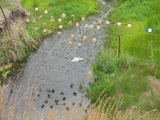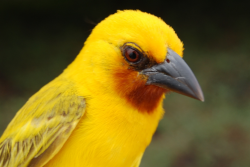Weaver species
Choose different species from drop-down list and press 'Go' button. See Full species list.Southern Brown-throated Weaver Ploceus xanthopterus
IUCN: Least concern Discovery: 069Categories: wetland, nectar, Nest use,
News items about species
Discovery
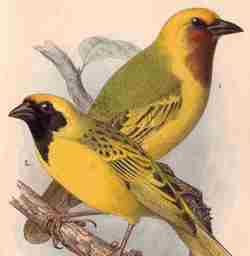
(S Masked Weaver in front) figure from Cabanis (1884) 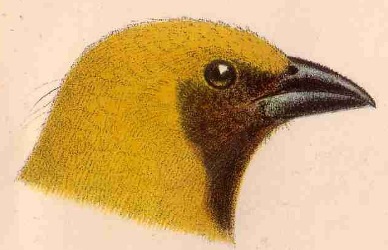
head of male, figure from Sharpe (1890) 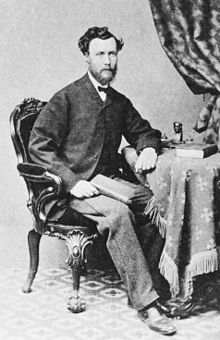
Southern Brown-throated Weaver, figure from wikipedia 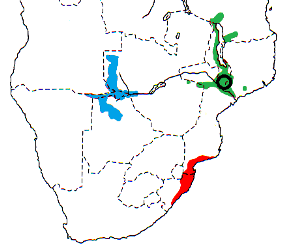
distribution, type locality circled IntroductionThe Southern Brown-throated Weaver was formally described by 2 authors: Karel Johan Gustav Hartlaub, a German physician and ornithologist, and Friedrich Hermann Otto Finsch, a German naturalist and colonial explorer.The description was published in a book about birds collected on Baron Carl Klaus von der Decken's travels in east Africa, but the book included birds from other collections, including the Southern Brown-throated Weaver. The Southern Brown-throated Weaver was collected by Sir John Kirk, a Scottish physician and naturalist. Kirk was part of David Livingstone's Zambesi expedition from 1858 to 1864, travelling from the mouth of the Zambesi upstream, and also exploring the Shire River, a northern tributary of the Zambesi. On a return from Lake Nyasa (Lake Malawi), the expedition boat was stuck in the Elephant Marsh on the Shire River during Nov-Dec 1861. Kirk collected the Southern Brown-throated Weaver while stranded here. When the rains came, the river started to rise and the expedition coninued, reaching the Mozambican coast in early Jan 1862. Kirk also collected many other birds and mammals along the Zambesi on this expedition, and sent most of these specimens to the British Museum. The first illustration of the Southern Brown-throated Weaver was of an adult male by Cabanis (1884). This was followed by a colour painting, of the head of a male, by Sharpe (1890). Scientific citationHyphantornis xanthopterus Hartlaub & Finsch 1870 Vog. Ost. Afr. p.399 Shire Valley, Nyasaland.Meaning of namesxanthopterus, Greek: xanthos, yellow; -pteros, winged.First English nameYellow-winged Weaver Bird (Layard 1884).Alternate namesBrown-throated Golden Weaver, Golden Weaver, Zambezi Brown-throated Weaver.CollectorSir John Kirk.Date collectedDec 1861.Locality collectedShire Valley = Elephant Marsh, Malawi.Type specimensThere is a type specimen in the British Museum (BM 1863.12.30.7). |
The above is based on Weaver Wednesday 2, a weekly series about the discovery of each weaver species.
This species text first appeared as
Weaver Wednesday [186] - Discovery [69]: Southern Brown-throated Weaver on 2016-01-06
1. Basic biology
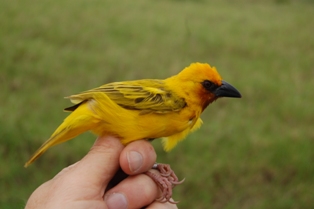
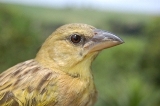 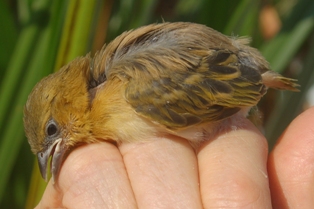 The Southern Brown-throated Weaver Ploceus xanthopterus is a small weaver, with a short tail. The breeding male is the only weaver in its range with a brown face and throat which are demarcated from the yellow head. Females, non-breeding males and young birds have a distinct cinnamon wash on the upperparts, and the bill is two-toned. It does not overlap in range with the similar Northern Brown-throated Weaver of East Africa. There are three subspecies of the Southern Brown-throated Weaver, with disjunct distributions (see map left, based on Birds of Africa):
There is one out of range record, Nest Record Card 100170, from Chiredzi in SE Zimbabwe. The Southern Brown-throated Weaver inhabits reeds and tall aquatic vegetation in wetlands. It forages in nearby riparian forest and other dense vegetation, but usually not far from water. It is usually found in small flocks (less than 20 birds), and it rarely associates with other weavers. Like other weavers, it undergoes a complete moult after breeding, but males start moulting while there are still eggs and chicks in nests. The furthest distance moved (from ringing data) is 8 km, and the oldest bird is 13 years (see here). The diet of the Southern Brown-throated Weaver is seeds, including grasses; berries; insects including moths, beetles, grasshoppers, caterpillars; flowers; and also bread in gardens. The Southern Brown-throated Weaver is colonial, with 10-300 nests per colony. It is polygynous, with males attracting 2-3 females. Females are double-brooded (in Malawi), using a new nest for the second clutch. The nest is an oval, with the entrance below, and without a porch. Nests are mostly built in reedbeds of Phragmites, Typha or Papyrus and rarely in trees. One colony of 20-30 nests was placed in a small Acacia overhung a birdbath. It may nest alongside Southern Red Bishop. |
The above is based on Weaver Wednesday, a weekly series about weaver species.
This species text first appeared as
Weaver Wednesday [38]: Southern Brown-throated Weaver on 2013-03-06
2. Breeding facts
| Pair bond Polygynous, with two or three females per male Breeding season Mar in Tanzania, Feb-Mar in Zambia, Oct-Apr in Malawi, Oct-Nov in Botswana, Nov-Mar (mainly Jan-Feb) in Zimbabwe and Dec in Mozambique; mainly Nov-Jan, with some earlier and later records, in South Africa Nest site placed chiefly in bed of Phragmites reeds, bulrushes or papyrus, occasionally in tree, c. 2.5 m above water or ground Nest building woven by male, lined by female Colony size Colonial, with up to 300 nests together Clutch size 2-3 eggs (average 2.4 in Malawi) Egg colour usually plain dark chocolate-brown or olive-brown, sometimes blue-green and heavily marked with grey-brown specks, or greenish-white with heavy red-brown markings Egg size average size of 45 eggs 21 x 14.5 mm (South Africa) Incubation incubation by female only, period 14-17 days Chicks and nestling period chicks fed by female alone, nestling period 14-19 days |
Breeding information based on Handbook of the Birds of the World, Vol. 15.
3. Photos of Weaver Nests
 Vm 29739 |  Vm 29699 |  Vm 29210 |  Vm 28673 |  Vm 28073 |  Vm 26741 |
Thumb-nails of most recent PHOWN records - click on one to see its full record
See all PHOWN records for this species here.
PHOWN (Photos of Weaver Nests) provides valuable info on breeding distribution and colony sizes of weavers.
You can contribute by registering and submitting photos at Virtual Museum webpage.
4. Breeding distribution
Google map showing distribution (For species with small ranges you need to zoom in at the correct area to see the range):
yellow blob - range of weaver species; read more about this here.
![]() - PHOWN records with photos
- PHOWN records with photos
![]() - PHOWN records with no photos (Nest Record Cards, other records)
- PHOWN records with no photos (Nest Record Cards, other records)
![]() - Birdpix records
- Birdpix records
![]() - comments on out of range records, or interesting records
- comments on out of range records, or interesting records
![]() - type locality
- type locality
CLICK on the marker on the map to see individual record details.
5. Range changes
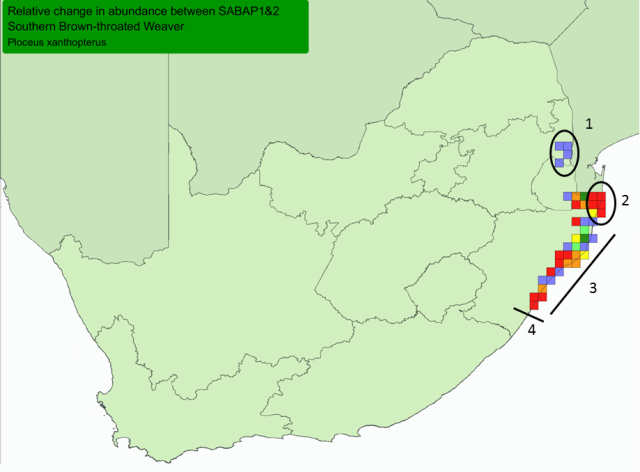
Red, orange and yellow = cells with very large, large, and small relative decreases Blue, dark green and light green = cells with very large, large and small relative increases. Cells = quarter-degree grid cells; Only cells with at least 4 checklists in both SABAP1&2 shown. All cells had this species recorded in SABAP1 or in SABAP2 or in both (more about interpretation at Biodiversity Observations 7.62: 1-13).
Range changes in SA
The points below match the points on the map above. Areas with very large increases include:
Areas with very large decreases:
Southernmost limit
Range changes elsewhereZimbabwe: range extension to Mashumbi Pools along Zambesi River (Masterson 1987a). | |||||||||||||||||||||||||||||||||||
The above is based on Weaver Wednesday 3, a weekly series about range changes in South African weaver species.
This species text first appeared as
Weaver Wednesday 3 [250] - Range changes [13]: Southern Brown-throated Weaver on 2017-03-29








